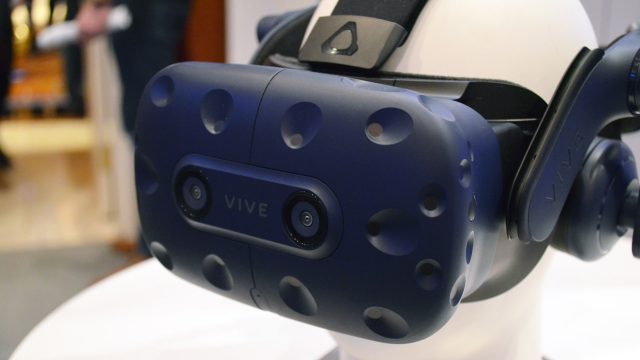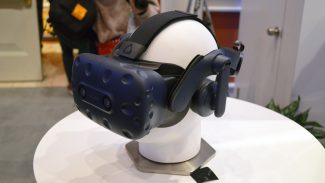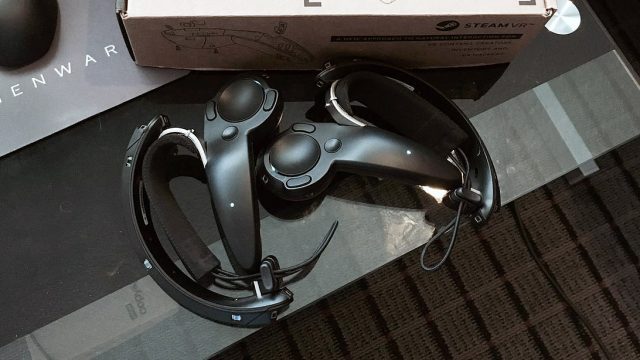Second Chance With a Second Camera

The single camera on the original Vive was initially intended to be used for pass-through video, and it was hoped that developers would find interesting ways to exploit it for other purposes. For whatever reason, developers haven’t seemed very interested, and even many users ignore its pass-through ability. For many, it seems like the Vive’s camera has been forgotten about.
Rather than scrapping it, HTC is giving the camera a second chance, this time pairing it up with a partner. With two cameras on the front, users should get a wider field of view for pass-through, and now the view can be 3D as well, which could make the difference in user traction thanks to stereo making it easier to interact with the real-world. If it’s more useful out of the box, perhaps developers will pay it more interest as well.
Stereo cameras could be more useful for what developers might dream up. For instance, attempts at hand-tracking and computer vision processing could be improved with stereo-disparity information. HTC doesn’t seem to be positioning the cameras as usable for inside-out positional tracking, but maybe someone will try to hack that together anyway.
SteamVR Tracking 2.0 Ready and Waiting
And then there’s SteamVR Tracking 2.0 support. When the Vive Pro launches later this quarter, it won’t ship with 2.0 base stations (it will be a headset-only offering initially), but it does have the latest sensors which will support the 2.0 base stations when they arrive.
The new sensors work with the 2.0 base stations to improve range; HTC says the Vive Pro will be able to track effectively up to 10 × 10 meter volumes. Up to four 2.0 base stations can also be used in conjunction for greater tracking covering. While most home users won’t be able to make use of all of that tracking space, it means the Vive Pro has greater tracking flexibility, either for consumers who want to push the limits, or for commercial/enterprise use-cases where large tracking spaces are more viable.
Knuckles Would Tip the Scale to Next-Gen

Update (1/15/18): HTC has confirmed that the Vive Pro will ship with updated wand controllers, not Valve’s Knuckles. More details here.
The idea of a ‘next-gen’ can be nebulous, but it’s generally taken to mean ‘a material difference from what came before’ and often ‘upgrades with little/no downgrades’. The Vive Pro, with its various improvements, feels like it’s almost into that next-gen territory, but still close to call. If the headset gets paired up with Valve’s forthcoming Knuckles VR controllers within the next six months or so, I think the complete package will pass that next-gen threshold.

Today at CES, HTC announced that the Vive Pro would be first shipping sometime in Q1 as the headset only. That means it would be used with the old Vive wand controllers, with both the headset and the controllers utilizing 1.0 tracking. HTC said that later in the year the Vive Pro will eventually ship with 2.0 base stations and controllers, but they didn’t specify which controllers. 2.0 base stations aren’t compatible with the current Vive wand controllers, so it will either be a the same wand controller with updated 2.0 sensors, or something completely new.
Valve has been in ongoing development of the new Knuckles controllers since at least last year. Kunckles are more compact than the fairly bulky Vive wands, and are effectively ‘worn’ on the hand as much as they are held. That allows the user to ‘let go’ of the controller as needed, while having something physical to grab onto when making a grabbing gesture. The controllers also offer capacitive finger sensing for finger tracking.

Given the way that Valve and HTC collaborated in the past to create the Vive, the natural conclusion is that HTC will eventually adopt the Knuckles controllers as part of the Vive system, but they have been tight lipped on when that might happen. It’s possible that the company will announce that Knuckles will be included with the Vive Pro when it’s packaged up with new controllers and the 2.0 base stations in a cohesive kit later this year, but we’ll have to wait and see.
The Big Question: Price
I talked a lot above about how I think the Vive Pro is a pretty impressive upgrade over the original Vive. It’s a very welcomed improvement that stands to make PC VR feel fresh for 2018. But a huge question remains, and it’s one that HTC purposefully steered clear of at today’s announcement: price.
No matter how good a headset is, a price point that feels too high can significantly hamper its ability to stimulate the market. HTC’s ‘Pro’ designation of the headset gives us pause. Although home users will be happy with the improvements, HTC’s positioning of the Vive Pro feels like its pivoting toward enterprise and commercial users. The company has been selling the ‘Vive Business Edition’ into those sectors at $1,200 pop; a price point that’s untenable even for many of the most hardcore VR consumers.
If the Vive Pro is priced any higher than the original Vive at its launch ($800), expect significant disappointment from the early adopters that have been evangelizing the Vive from their homes. HTC says they’ll share more specifics about availability and pricing of the Vive Pro later this year. Only then will we have a clear picture of how much of a splash the headset stands to make.






